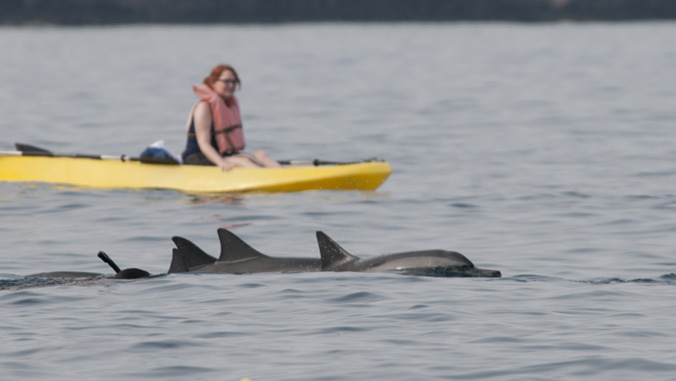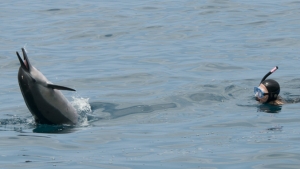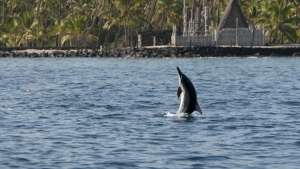
Wild dolphin-swim tourism has grown in specific locations where Hawaiian spinner dolphins have known resting habitat. Under normal operations, Hawaiʻi’s dolphin-swim tourism industry is estimated to generate hundreds of millions annually according to a study by the University of Hawaiʻi at Mānoa, Duke University and York University published in Frontiers of Marine Science. The study offers the first revenue estimates that can provide context for the impact and economic role of the dolphin-swim industry in the state.
Researchers found that increased growth in dolphin-swim businesses, under normal operating years, has created an industry in Hawaiʻi that earns more than an estimated $102 million annually, based on numbers collected in 2013. Since the industry has continued to grow, it is likely this number has also increased.
The study estimates revenue generated from two popular locations, Waiʻanae, Oʻahu and Kailua-Kona, Hawaiʻi Island, offering an accountability exercise regarding wild dolphin-swim demand and an annual estimate of the number of viewing participants and revenue earned.


“What surprised us was the study showed that dolphin viewing companies are making a larger profit than dolphin-swim businesses by an estimated $19 million per year,” said Carlie Wiener, PhD, an affiliate faculty in UH Mānoa’s geography department and lead-author of the study. “There are sizable differences between businesses in Kona and Waiʻanae, which has significant impacts for how these businesses are managed. We see this paper as a first step for policy makers looking to implement management in areas where tourism occurs, and can provide context for further discussion on the ecological impact and economic role of the dolphin-swim industry in the state. We need to take into account protection for the dolphins, but also the livelihoods of the tour operators.”
The paper also breaks down the average lifetime revenue generated by a dolphin, showing that an individual spinner dolphin can generate an estimated $3,364,316. This analysis serves as a call for further research into the monitoring and regulation of wildlife tourism in Hawaiʻi.
Regulation and management
These observations have important considerations as the state of Hawaiʻi considers new regulations and management of the dolphin-tourism industry and offers resource managers a way of planning for future growth and risk assessment of a previously underestimated component of the marine tourism industry in Hawaiʻi. In 2005, NOAA published an Advanced Notice of Proposed Rulemaking aimed at reducing impacts by implementing time-area closures in spinner dolphin resting bays.
While no rules have yet been implemented, on August 23, 2016, NOAA Fisheries published a proposed rule to enhance protections for Hawaiian spinner dolphins to prevent disturbance and harassment from dolphin-directed human activities.
“NOAA is currently evaluating management options for the protection of spinner dolphins in Hawaiʻi,” said Lars Bejder, PhD, an associate researcher at UH Mānoa’s Hawaiʻi Institute of Marine Biology and co-author of study. “This is particularly important given that recent research has identified that spinner dolphins in resting bays off the Kona coast have the highest exposure rates to human activities anywhere in the world. High exposure rates to humans within critical habitats is cause for concern for the long-term viability of the dolphins and hence the dolphin-tourism industry. It is paramount that appropriate regulations are implemented to ensure long-term sustainability.”
“NOAA’s proposed rule intends to reduce the harassment of Hawaiian spinner dolphins, while essentially establishing what are standards of behavior for the public, including the wildlife tourism industry,” said Ann Garrett, Assistant Regional Administrator at NOAA’s Pacific Islands Regional Office. “Nature-based tourism is growing worldwide, and like this study suggests, such opportunities can be good for the local economy. However, if wildlife viewing practices cause animals to be under a chronic state of disturbance, then we run the risk that the disturbance could lead to negative population level effects. If this happens, everyone loses out. By clearly identifying measures to prevent the disturbance and harassment of Hawaiian spinner dolphins, NOAA hopes to support a sustainable model for dolphin wildlife viewing in Hawaiʻi.”


